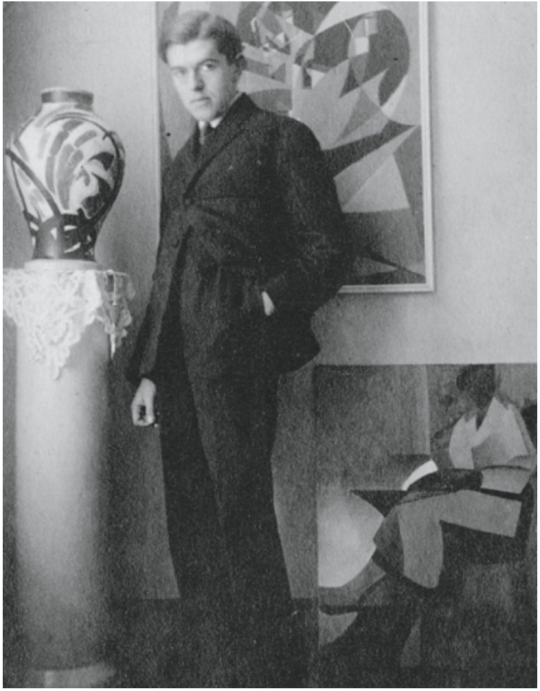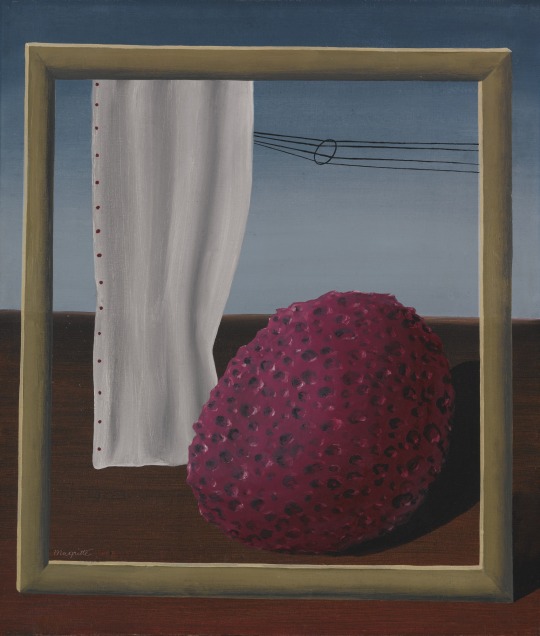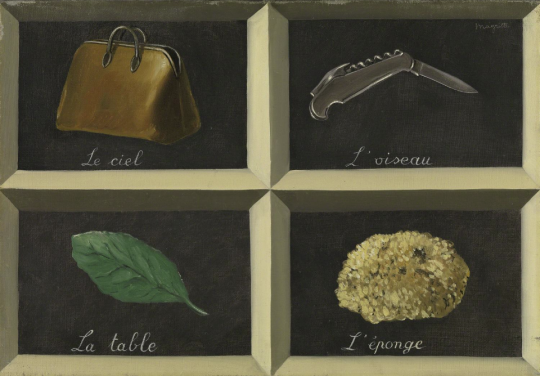
René Magritte in March, 1921. Photographer unknown, Courtesy of Menil Archives, The Menil Collection, Houston.
By René Magritte
One may be “struck” by the word Thought.
Our thoughts are “concerned” with sensations, feelings, reflexes, preferences, activities, ideas, beliefs and various preoccupations, as if the thought that “coincides” with these “things” was the only thought possible, as if the thought that “coincides” still deserved to be called thought.
“It doesn’t matter!” some will say. “It’s the pleasure of a pleasant and powerful sensation that counts!” Or: “It’s the fulfillment of my duty!” But, without a doubt, for something to “count”, thought is necessary to “appraise” pleasure or duty.
The hand that goes too near the fire and the reflex that makes us cry out in pain and draw back the hand from the flames “counts”, at the same time, to thought, which is obliged to be “concerned” about a painful sensation and a reflex action. It coincides exactly, at that moment, with these two things. The coincidence is no less exact when, at other moments, thought “takes into account” the worries and doubts it envisages. It is the same coincidence when it is a more complex question of turning one’s thoughts to even more things simultaneously. For instance: the subtle taste of a soup, your hostess’s beauty, a notion of the origin of thought or a professional problem.

Le Message À La Terre, Renè Magritte, 1926. Oil on canvas. 29.5 by 25 5/8 in.
*
To think of an image means Seeing an image.
The painting gives the sense of sight a visible image. The sense of sight registers the image in the picture in reverse, without Seeing, according to the laws of optics, like a camera. This image becomes a mental image, that is an image with a psychic value. It is thought that gives this value.
*
Images may be endowed with false values: commercial “value” for instance; or again the value of size prized by those who are obsessed with the metric dimensions of a canvas, by resolute partisans of large or small portions of space, by champions of fresco cementing, of mounting, of genuine craquelure and the composition of paint and remounting paste, by experts in anatomy, perspective or shadows cast.
The values that truly concern the image depend, according to personal preference, on one or two aesthetic theories which determine the creation of the resulting pictures.
Fear of being mystified assuredly affects the painted image that has the power to induce such a fear.
We are quite “safe” when we are choosing between the glory of the Impressionists, the dynamism of the Futurists, the Cubism of Picasso, the abstract art of Mondrian or Archipenko and the genius of de Chirico. We may also value the last conventional “Prix de Rome” or else “get a buzz” from the “young” (and the old) who bewilder art critics by “discovering” abstract and non-figurative art in 1954.

The Interpretation of Dreams (La Clef des songes), Renè Magritte. 1927 14 15/16 × 21 5/8 in.
*
Women, children and men who never think about art history have personal preferences just as much as aesthetes. Disagreement among these preferences cannot be explained by the influence of different “environments”. In fact, “Siamese twins” generally have dissimilar tastes and opposing beliefs, just as an individual who is torn, notably by his conflicting desires. If differences of feeling are “explained” by the structure of the “grey matter”, this is obviously not a particularly helpful “explanation”, and it resembles very much the answers given by Molière’s doctors.
Thought enables us to offer an “explanation”. Thought gives it its value. Whether the explanation is theological, metaphysical, psychological or biological, it is “uttered” by thought, which explains, though itself inexplicable, whatever may be said about it.
We could no doubt go on living without thinking, like plants—we don’t know if they “think”. Thought gives life its value. All values are the gift of thought. What gives is free. Thought is essentially free. It is Light. However, in the ordinary and extraordinary moments of life, our thought does not manifest its freedom to the full. It is constantly threatened, affected by everything that happens to us. It coincides with a hundred and one things which restrict it. This coincidence is almost permanent.
Thought has some degree of freedom when, for instance, it gives value to our feeling for a stone or when it bestows the highest value on life and the Universe on which life depends. For the sake of freedom of thought we must admire Ruskin, the art lover who wrote: “Let all works of art perish rather than the birds that sing in the trees.”
*
Life, the Universe, the Void have no value for thought when it is completely free. The only thing that has value is Meaning—that is, the moral concept selected writings of the Impossible. To think of Meaning the mind has to free itself from ordinary, nearly ordinary and extraordinary ideas.
In the field of art, thought is generally deprived of all freedom through respect for dead traditions or subservience to ridiculous fashions.
The absurdity and cruelty of the world cries out for the generous heart to rebel and thoughts turn to justice.
My paintings are images. You cannot give a valid description of an image unless thought is guided towards its freedom. You must also pay attention to both the image and the words which have been chosen to describe it. The description of the painted image, which has become a mental image, must be endlessly perfectible. Moreover, it is important to be wary of using certain inappropriate words (abstract, concrete, consciousness, unconsciousness, temperament, ideal, etc.)
I consider any verbal attempt valid which says that my paintings have been conceived as material signs of the freedom of thought… They aim “as far as possible” not to devalue Meaning—that is, the Impossible.
If the question “What is the meaning of these images?” could be answered, it would be tantamount to making Meaning, the Impossible, resemble a possibility. To attempt to answer would be to recognize there was a “meaning”. The viewer can, with the greatest possible freedom, see my images as they are, while trying, as their creator does, to think of Meaning, which means thinking of the Impossible.
This is an excerpt from the Reneé Magritte: Selected Writings (University of Minnesota Press, 2016). This piece was originally published in Catalogue de l’exposition Magritte, Brussels, Palais des Beaux-Arts, May 1954 (W 468), pp. 5–8.
Copyright 2016 C. Herscovici / Artists Rights Society (ARS), New York and ADAGP, Paris
English translation copyright 2016 Jo Levy and Calder Publications, an imprint of Alma Books Limited.




